Dragonflies and Damselflies at the Paul Wightman Subterranean Nature Preserve
Article and photographs by Dr. Joe and Pat Roti Roti.
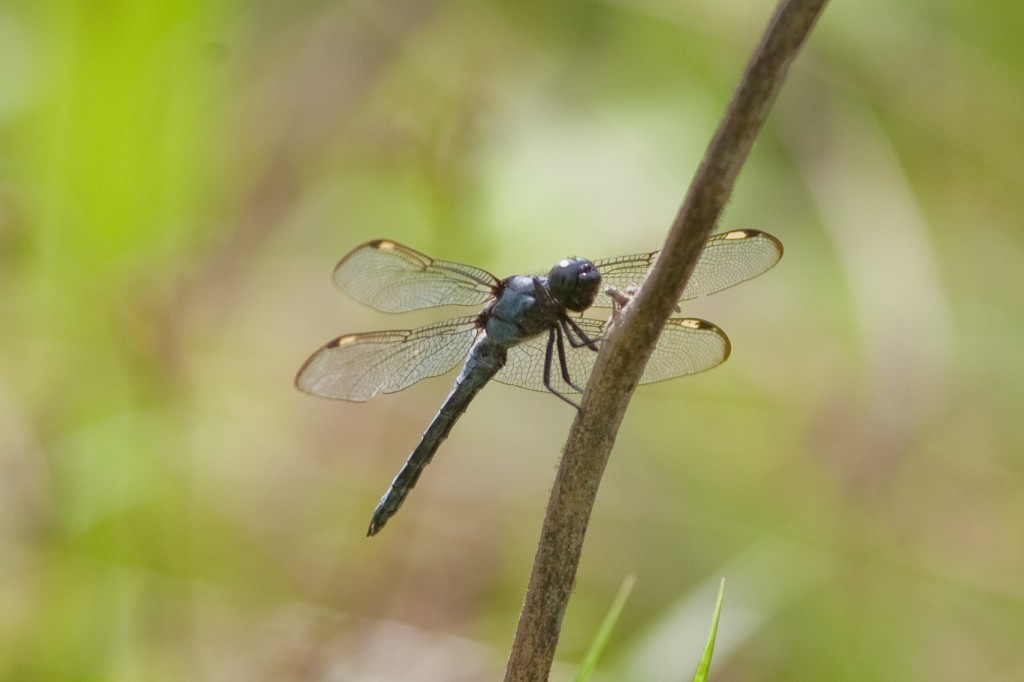
A male Spangled Skimmer at PWSNP. This dragonfly is characterized by the small black and white spots near the wingtips.
During the prairie restoration and site access development at the Paul Wightman Subterranean Nature Preserve (PWSNP), we have conducted initial surveys of the Odonata (dragonflies and damselflies) populations. The goals of this work are twofold: first, there is a conservation interest and opportunity for citizen science activity; second, there are excellent opportunities to develop a public outreach program to present the fascinating world of dragonflies and damselflies and to illustrate their role as indicators of pond and stream quality.
Why are we interested in dragonflies and damselflies? There are two answers. First dragonflies are very watchable insects. A close look at a dragonfly will typically reveal remarkable coloration or combinations of colors on the thorax and abdomen. In particular, the eyes have dramatic coloration and brightness. As a result dragonflies have an impact on arts and crafts. As an example, during a visit to a typical jewelry store, one will likely find several examples of dragonfly jewelry. Dragonflies also have a cultural impact with some countries (such as Japan) having dedicated dragonfly parks. Secondly, Odonata are good indicators of environmental stream and wetland quality. While a few Odonata species are rather tolerant of poor quality water, there is a spectrum of fussiness such that a high quality environment will show a larger diversity of species and the presence of more uncommon species. Thus the restoration of native prairies at PWSNP provides an excellent opportunity to observe changes in the Odonata populations.
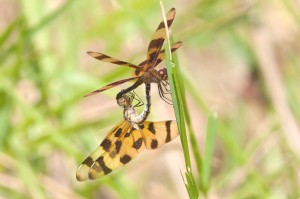
Male and female Halloween Pennants in wheel at PWSNP. These dragonflies are characterized by their colorful wings: orange and black for the male and yellow and black for the female.
The goal of the survey project is to document and monitor the Odonata species at the PWSNP as the prairies are restored and public access is developed. It is hoped that the study will show an increase in the diversity of dragonfly and damselfly species and possibly individual numbers as the native habitat is restored. However, as we describe below, the preliminary surveys suggest that the PWSHP already has a good variety of dragonfly species, so we might expect a modest rather than a dramatic increase in the number of dragonfly and damselfly species. Another point that impacts the types of dragonflies and damselflies we would expect to see is the nature of the PWSNP watershed. Specifically, most of the drainage is via sinkholes and there is a lack of significant surface streams on the site. Therefore, we expect not to see Odonata that prefer rivers or streams. On the other hand, we expect that many of the ponds are fishless and therefore we expect to see those Odonata that avoid water with predatory fish populations. This expectation has been confirmed in the preliminary survey which showed the presence of Comet Darners, a species that avoids fish, in at least two ponds.
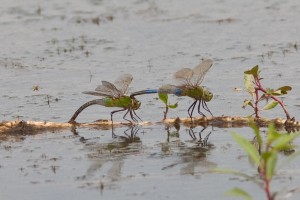
Female and male Common Green Darners at a PWSNP pond. These dragonflies are characterized by their larger size (not apparent in the photograph) and their green thorax.
To accomplish the study, we are taking the following approach:
1. Survey PWSNP six times during a year according to a protocol developed by Steve Taylor PhD, Illinois Natural History Survey, University of Illinois-Urbana.
2. Photograph and/or collect species that are not currently on any check lists for Monroe County.
3. Submit voucher specimens to U of I and photographs to www.Odonatacentral.org for vetting and documentation of the species’ presence at that site.
By completing the study we expect to contribute to a more complete picture of the distribution of common and uncommon dragonflies and damselflies in Southwestern Illinois.
In progress to date, we have made three surveys in 2015 and two surveys in 2016. In 2015 we surveyed eight ponds and six overland routes (trails were not yet marked). Pond 10 was surveyed three times, while ponds 9, 11, 15, 29 and 32 were surveyed twice. Thus the 2015 results are considered base line and are preliminary. Based on the 2015 results, PWSNP shows a good variety of dragonfly species (14 plus 1 damselfly). Several new county records will need to be submitted. The 2016 data is still being collected. However we can add two, possibly three damselfly species to the list. Consistent with expectation, no species that prefer streams have been observed so far. Good news for the site, but more challenging for the study is that we are seeing good base line biodiversity. Therefore we are expecting to see a modest (rather than a dramatic) increase in biodiversity. Documenting a modest increase above any given base line usually requires more data collection and a longer study time.
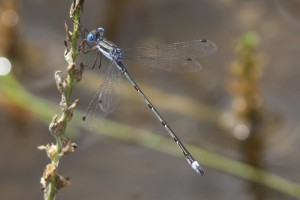
A Southern Spreadwing at PWSNP. Spreadwings are characterized by holding their wings at a 45 degree angle as opposed to horizontal in dragonflies or vertical in damselflies.
While the already significant Odonata biodiversity at PWSNP may present challenges in documenting changes associated with prairie restoration, it also makes it an excellent site for Odonata observation and public outreach. First it should be possible to observe a large numbers of species in a single visit. In each of our visits (except for rainouts), we have seen between 10 and 14 species each visit. Second many of the ponds have good access for viewing. It is possible to view a variety of dragonfly behaviors and even observe species related variations in typical dragonfly behaviors, such as mating and ovipositing. The trails and observation points are still under development. However we have found excellent observation points at several ponds, which are candidates for future public access. Our first public outreach event will be a field trip July 30, 2016. This will be an excellent opportunity for an introduction to dragonfly observation. For those with some expertise in Odonata, there is an opportunity to observe some less common species and possibly find some new county records. Pat and Joe will lead the Clifftop field trip at the Paul Wightman Subterranean Nature Preserve from 10 am to 2 pm. on Saturday 30 July. Registration is required by July 28th and may be done by email to Clifftop@htc.net or by calling 618-458-4674.
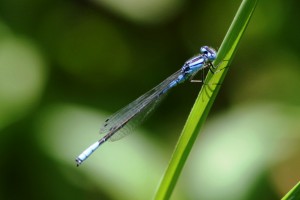
An Azure Bluet, one of the most common damselflies at PWSNP. The males of these damselflies are characterized by the almost solid black in the middle of the abdomen and long patch of blue on the abdomen tip.
Dr. Joe Roti Roti is retired from Washington University School of Medicine; Pat Roti Roti is a CPA in St. Louis. Joe and Pat are Master Naturalists and devote much of their time to studying dragonflies and damselflies and to a prairie restoration on their property.
CLIFFTOP, a local nonprofit organization, is focused on preserving and protecting area bluff lands.
A version of this article appeared in the 15 July 2016 edition of the Monroe County Independent.
© 2016 all content rights reserved Clifftop NFP
Comments are currently closed.
